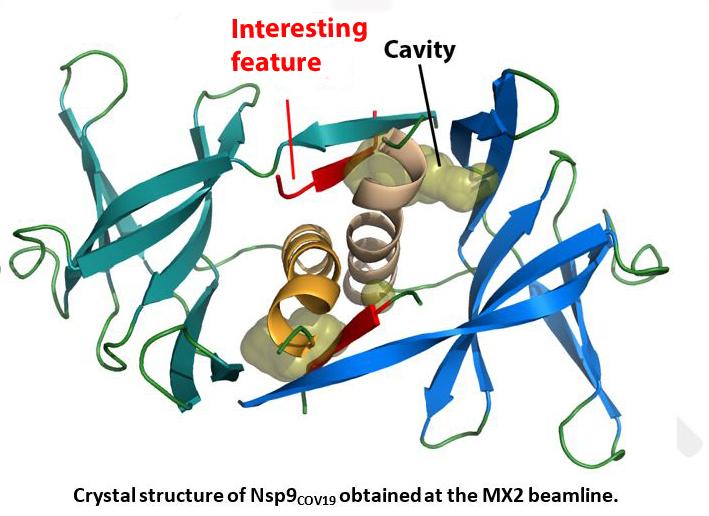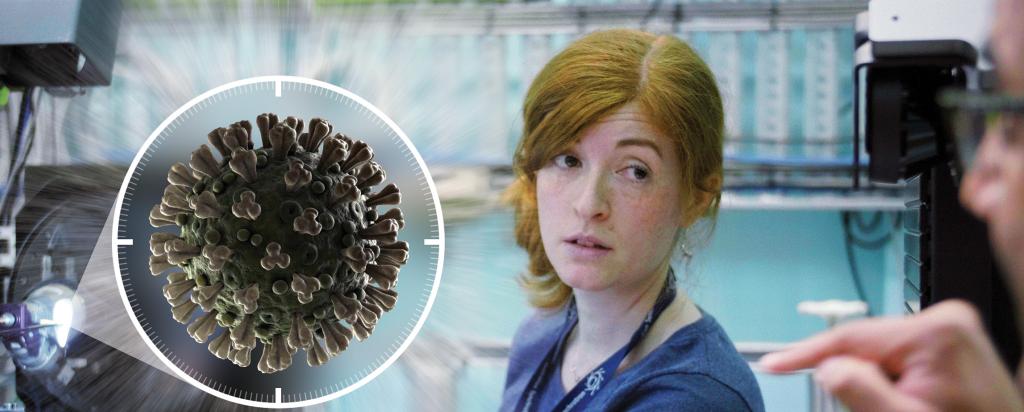

Published on the 7th April 2020 by ANSTO Staff
Key Points
-
Monash University researchers identified structure in virus that causes COVID-19 which could be used in screening potential therapeutic drugs
-
The structures could be targeted to block the ability of the virus to infect and replicate in the body
-
The macromolecular crystallography beamline at the Australian Synchrotron was used to produce a molecular map of the protein
A team of Monash researchers have determined the 3D-structure of a SARS-CoV-2 protein at atomic resolution using the macromolecular crystallography beamlines Australian Synchrotron.
The Nsp9 protein in SARS shares 97 percent of its sequence with its counterpart from COVID-19. The researchers cloned a version of the CoV-19 Nsp9 protein for the experiments.
These structures, which were described in a paper published in iScience, could potentially be used in drug screening and in targeted experiments to disrupt replication of the virus.
Determining the shape of a protein is a key step in understanding its function and role in replication of the virus.
The Monash researchers also identified a new component of the protein, a macromolecular complex and are in the process of determining how it impacts the function of the protein.

The COVID 19 virus only produces 27 or so proteins. Scientists across the world are currently trying to understand how to prevent the production of these proteins inside our cells when the virus repurposes our bodies to promote its lifecycle.
Research Fellow Dr Dene Littler, within the laboratory of Prof Jamie Rossjohn from the Biomedicine Discovery Institute, Faculty of Medicine, Monash University, has been examining some of the lesser-understood proteins produced by SARS-CoV-2.
One of these, the non-structural protein 9 (Nsp9) is thought to have a role in RNA binding and the related version of the protein in SARS is known to be important for replication of the viral genome.
“This will be part of a broad strategy by the world's scientists to develop entirely new drugs that are specifically targeted at corona viral proteins, blocking the virus’s ability to infect and reproduce in human cells,“ said Littler.
“Viruses such as those that cause the common cold haven’t had sufficient health implications before to warrant large scale drug research programs.
However, in the face of the current pandemic that has obviously changed and we are playing a fast-paced game of catch up”.
“Technological developments such as those made possible by the Australian synchrotron spurred the first forays into rational drug design, in which scientists study the structure and function of molecules in order to work out what drugs might bind to them,” explained Littler.
In the case of viruses, the intent is to limit their ability to reproduce and allow a patient’s immune system to recover and fight the infection.
Rossjohn said, “This represents the start of an accelerated program of research within Monash that is aimed at developing new anti-viral treatments as well as understanding how the immune system combats this virus”.

Scientists at the Australian Synchrotron gaining insights into the structure of proteins (Left to right) Eleanor Campbell, Sukritee Bhaskar, Alan Riboldi-Tunnicliffe
The Australian Synchrotron fast tracked access to the microfocus crystallography beamline (MX2) for the COVID-19 related research.
Using the new ACRF detector on the MX2 beamline, it took approximately 18 seconds to acquire a data set, which was then used to quickly construct a crystal structure of Nsp9,” said Principal scientist Dr Alan Riboldi-Tunnicliffe.
“MX2 has a powerful narrow beam, which enables us to focus on particular parts of a crystal. The instrument’s ability to capture molecular detail enables you to see how crucial interactions, such as binding. This is important in assessing drug interactions,” said Riboldi-Tunnicliffe.
“One of the reasons the research is so interesting is that it does not focus on the established strategy of targeting a protease. Dene looked at Nsp9 because it has an RNA binding site that has been conserved over its evolutionary history. This means it is less likely to mutate in response to an intervention,” said Principal Scientist Dr Rachel Williamson.
The Australian Synchrotron has kept the MX2 beamline operational in response to the COVID-19 crisis. Researchers are able to send samples to the Synchrotron and use the instrument remotely.
The Synchrotron has received samples relating to CoVID-19 from Australia, Singapore and China to date.

